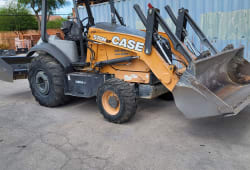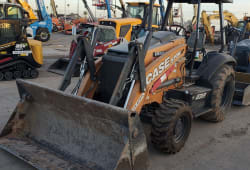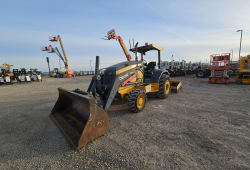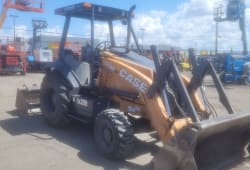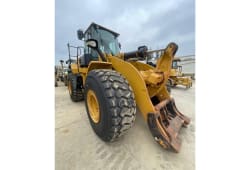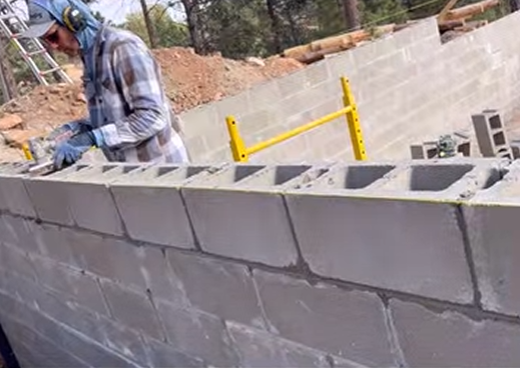Common Problems with Caterpillar Wheel Loaders and How to Fix Them
10 Min read
)
September 10, 2023
Cat wheel loaders are robust workhorses vital for a range of construction and industrial tasks. Yet, like any machinery, they're not immune to common problems that can impede productivity. In this comprehensive guide, we'll delve into the typical challenges that Cat wheel loader operators often encounter. From ride control adjustments to electrical system maintenance, we'll offer practical solutions and troubleshooting tips to keep your equipment running smoothly. Whether you're a seasoned operator or a newcomer to these machines, this guide will prove invaluable in ensuring the efficiency superior performance, and reliability of your Cat wheel loader in the face of common challenges.
Common Problems in Cat Wheel Loaders
:format(webp))
Telehandler forklifts come in a variety of sizes, from compact, small wheel loaders, to large wheel loaders, to accommodate different needs.
Engine Problems
Low oil pressure
Low oil pressure is a critical engine problem that can lead to severe damage if not addressed promptly. Check the oil level and quality regularly, and if you notice low pressure, inspect for leaks, worn oil pumps, or clogged filters. Replacing faulty components and maintaining proper oil levels will help ensure the engine operates smoothly.
Overheating
Engine overheating is often caused by issues with the cooling system, such as a malfunctioning thermostat, radiator blockage, or coolant leaks. Regularly clean the radiator, replace damaged hoses, and maintain the coolant level to prevent overheating and potential engine damage.
Engine knocking
Engine knocking can indicate various problems, including worn-out bearings, loose components, or contaminated fuel. Diagnose the issue by inspecting the engine components and addressing any loose parts or replacing damaged components. Ensure you use high-quality fuel to prevent knocking.
Hydraulic Problems
Low hydraulic fluid level
Low hydraulic fluid levels can lead to poor loader performance. Regularly check and maintain the hydraulic fluid level, inspect for leaks, and replace any damaged hydraulic hoses or seals to prevent system failures and ensure optimal power and loader functionality.
Leaking hydraulic hoses
Leaking hydraulic hoses are a common issue that can result from wear and tear. Inspect hoses for damage and replace them if necessary. Properly tightening connections and using high-quality hoses will help prevent leaks.
Faulty hydraulic pump
A faulty hydraulic engine model pump can cause performance problems and slow operation. Regularly inspect the pump for wear and damage, and replace it if needed. Routine maintenance and using genuine Cat parts can extend the hydraulic engine model pump power itself's lifespan.
Transmission Problems
Hard shifting
Hard shifting can be caused by issues with the transmission fluid or damaged transmission gears. Regularly check the transmission fluid level and quality. If problems persist, consult a mechanic to inspect and repair the transmission gears.
Leaking transmission fluid
Transmission fluid leaks can lead to gear wear and poor shifting. Inspect the transmission for leaks and repair any damaged seals or components promptly. Regularly changing the transmission fluid and filter can also prevent fluid-related issues.
Damaged transmission gears
Damaged transmission gears can result in performance issues. Inspect the gears for wear or damage and replace them as needed. Routine maintenance and proper operation can extend the lifespan of your transmission components.
Common Brake Problems
Low brake fluid level
Low brake fluid levels can compromise braking, handling, and fuel efficiency in loaders too. Check the brake fluid reservoir regularly and maintain the proper level. Inspect for leaks, and if necessary, replace worn brake lines and seals to ensure your loader's braking system functions safely.
Worn brake pads
Worn brake pads can reduce braking effectiveness. Regularly inspect and replace brake pads when they show signs of wear. Using high-quality brake pads and following recommended maintenance intervals is essential for safe operation.
Faulty brake calipers
Faulty brake calipers can lead to uneven braking or brake drag. Inspect the calipers for damage and replace them if necessary. Proper maintenance and regular lubrication can prevent caliper issues.
Seized brake rotors
Seized brake rotors can cause uneven braking and reduce wheel loader safety. Inspect and maintain the brake rotors, ensuring they are clean and properly lubricated. Replacing damaged rotors is essential for reliable braking performance. The Caterpillar wheel loaders have a maximum operating weight of 100 tons and a maximum gross power of 1,000 horsepower, making them ideal for material handling applications.
Electrical Problems
Blown fuse
Encountering a blown fuse is a common electrical hiccup that can disrupt various systems in your equipment. When faced with this issue, the first step is to pinpoint the faulty fuse, usually by visually inspecting the fuse box. Once identified, replace the blown fuse with one of the correct amperage ratings, ensuring it matches the manufacturer's specifications. However, it's equally vital to investigate the root cause of the blown fuse to prevent recurring electrical problems. Addressing the underlying issue, whether it's a short circuit or excessive electrical load, is essential for maintaining the reliability of your equipment's electrical systems and minimizing downtime.
Faulty wire harness
Dealing with a faulty wire harness is paramount for the smooth operation of any equipment, as it can lead to a host of electrical malfunctions. To address this concern, conduct thorough inspections of the wire harness, paying close attention to damaged wires or loose connections. When identified, replace the problematic sections promptly to ensure proper electrical connectivity. Furthermore, it's crucial to securely fasten the wire harness, avoiding any pinching or abrasion that could lead to future problems. By proactively managing wire harness integrity through regular inspections and preventive measures, you can maintain reliable electrical systems and prevent costly downtime in your equipment.
Bad battery
A weak or bad battery can be a source of frustration, leading to starting problems and electrical issues in your equipment. To prevent such headaches, make it a routine to test the battery regularly. If the tests indicate a weak or failing battery, don't hesitate to replace it promptly. Additionally, maintain the battery terminals diligently by keeping them clean and tightened. This simple yet crucial practice ensures a reliable electrical system, minimizing the risk of unexpected breakdowns and disruptions in your equipment's operation. Regular battery maintenance and timely replacements are essential for uninterrupted and efficient performance.
Corroded electrical connectors
Corroded electrical connectors can wreak havoc on equipment reliability by disrupting crucial electrical connections. To address this issue, begin with a thorough inspection of connectors to identify any corrosion. If corrosion is present, promptly clean or replace the affected connectors as necessary to restore proper electrical conductivity. Additionally, consider applying dielectric grease to connectors as a preventive measure. This specialized grease helps create a barrier against moisture and environmental factors, reducing the likelihood of future corrosion and preserving the integrity of the electrical connections. Regular maintenance practices like these can significantly enhance equipment reliability and prevent costly downtime due to electrical issues.
Ride Control Problems
The ride control not working
When the ride control system on your Cat wheel loader fails, it can have detrimental effects on both loader stability and operator comfort. To resolve this issue, begin by diagnosing the problem through a systematic approach. Check the ride control system's sensors, inspect the wiring for any signs of damage or loose connections, and scrutinize the hydraulic components for leaks or malfunctions. If the problem persists or seems complex, it is advisable to consult the equipment's manual for specific troubleshooting steps. In cases where a resolution remains elusive, seek professional assistance from qualified mechanics or technicians with expertise in Cat wheel loader systems. Timely attention to ride control issues is essential for maintaining operational efficiency and operator safety.
The ride control is too stiff
When confronted with a ride control system that feels excessively stiff, it's imperative to address the issue promptly. An overly stiff ride control can adversely impact load handling and operator comfort, potentially leading to reduced efficiency and operator fatigue. To remedy this problem, focus on adjusting the improved control system settings within the manufacturer's recommended range. This adjustment aims to strike a balance between achieving the desired ride quality and optimizing loader performance. By fine-tuning the ride control settings, you can enhance load handling capabilities and operator comfort, ensuring a smoother and more productive operation overall.
The ride control is too soft
When dealing with a ride control system that feels excessively soft, it's crucial to address this issue promptly. An overly soft ride control can compromise load stability, posing safety risks in various applications. To rectify this problem, focus on adjusting the system settings within the manufacturer's recommended range. This adjustment aims to strike a precise balance between ride comfort and operational demands. By fine-tuning the ride control settings, you can enhance the loader's stability while ensuring a comfortable loading experience for the operator, ultimately contributing to safer loading and more efficient operations.
How to troubleshoot common Cat wheel loader problems
To effectively troubleshoot common Cat wheel loader problems, adhering to a few essential practices is crucial. Begin by prioritizing regular maintenance routines to keep your loader in optimal condition. Perform thorough inspections, checking for wear and tear, loose components, or leaks, ideally on a scheduled basis. Swiftly address any issues that arise during these inspections to prevent them from escalating. Additionally, consult your equipment manual for manufacturer-recommended troubleshooting steps, which can provide specific guidance for various problems. Furthermore, implement a preventive maintenance schedule to proactively address potential issues, ensuring minimal downtime and maximum productivity in your operations.
When to call a mechanic
While routine maintenance and basic troubleshooting can resolve many issues, some problems may require the expertise of a qualified mechanic. If you encounter complex or persistent problems beyond your expertise, it's advisable to seek professional assistance to ensure the safety and reliability of your engine model and your Cat wheel loader power itself.
Conclusion
In conclusion, Cat wheel loaders are invaluable assets in construction and industrial operations, but they can encounter various problems over time. Regular maintenance, proactive inspections, and timely repairs are crucial for preventing and addressing these issues. By following the guidelines and solutions provided in this guide, you can keep your Cat wheel loader operating efficiently and extend its lifespan, ultimately maximizing your investment in this essential equipment.
We use a variety of Cat engine-powered small and medium wheel loaders to load materials safely from one place to another place even if you can use it in a steel mill.

Caleb Woods is an experienced content specialist and an editor at Boom & Bucket, blending his journalism background with expertise in the heavy equipment industry. He delivers engaging, informative content to help professionals stay informed and make smarter decisions in the machinery market.

